The rank of sub-ensign in the Russian army
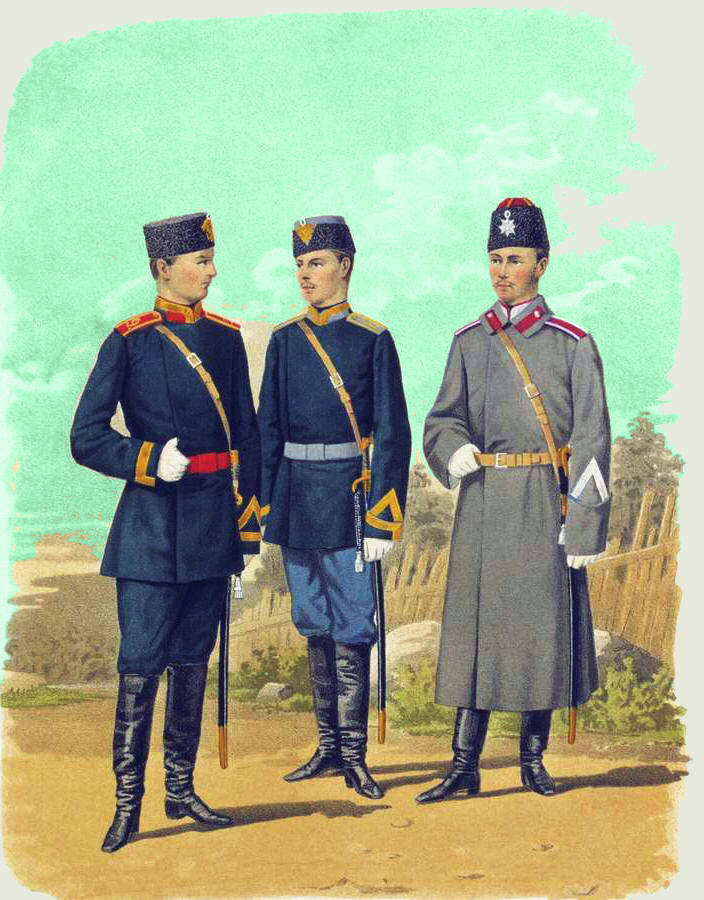
In Russia, in the 17th — 20th centuries, the ensign was one of the non-commissioned officer ranks, first introduced by the Decree “On the ranks of the military” in 1680 for all regiments - archer, soldier and reiter, with a status higher than the corporal and lower than the ensign. In 1698 — 1716, before the adoption of the Petrovsky Military Regulations, the sub-ensign was below the status of a lieutenant and a sergeant by status. In 1716 — 1722, before the adoption of the Table of Ranks, the ensign on status was higher than corporal and lower than captainarmus, then before 1765 of the year - higher than captenarmus and below sergeant. In 1765 — 1798 — above captainarmus and below the junior sergeant; in 1798 — 1826 — above the junior noncommissioned officer and below the sergeant major. In Guards, from 1838, the title of ensign was abolished and reinstated only in 1884, although it was kept as an optional title for students of educational institutions of the guard, equal to the rank of Junker, until 1859. In the life campaigns in 1741 — 1761, the ensigns belonged to the VIII class of the Table along with the Fourier and vice-sergeants, that is, they were equated with the captain-lieutenants of the guard.
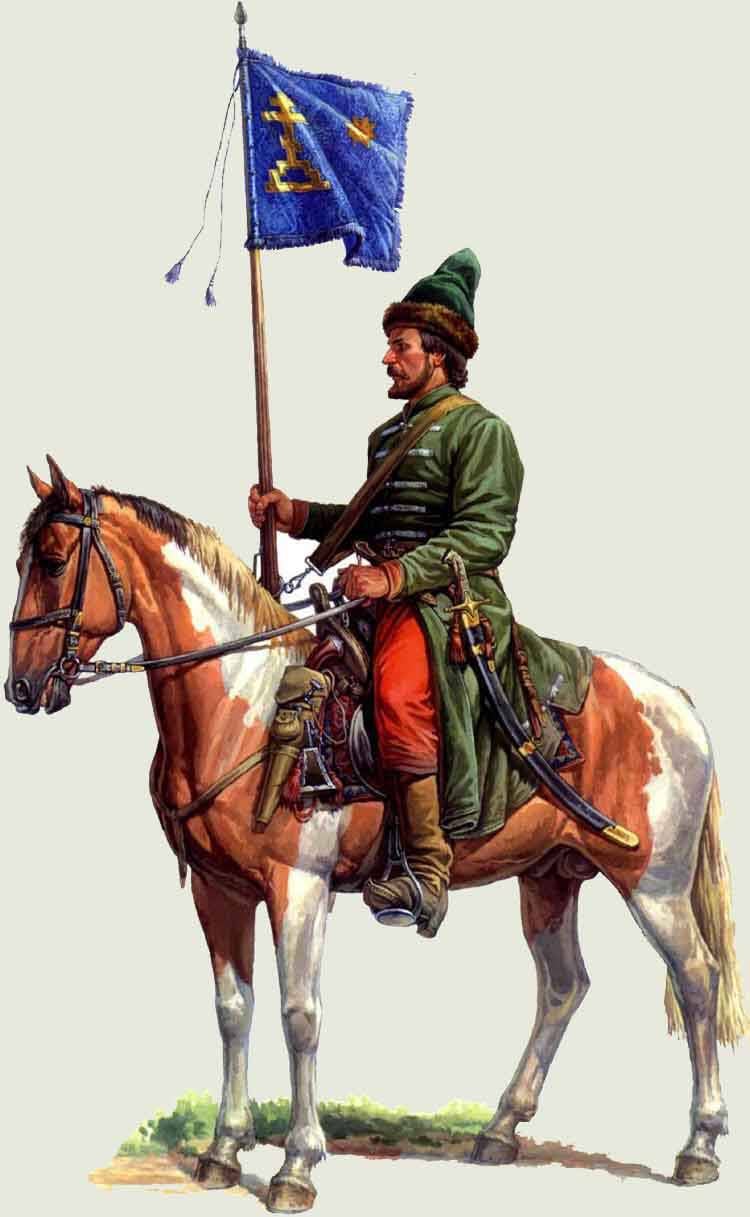
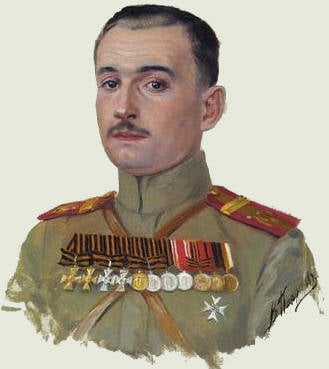 Lieutenant Dudnikov. Portrait work V.A. Poyarkova.
Lieutenant Dudnikov. Portrait work V.A. Poyarkova.In the portrait of the full St. George Cavalier Dudnikov on the shoulder straps of the ensign, you can clearly see Feldwebel tabs sewn on top.
From 1716, in accordance with the Peter Charter, the ensigns were assigned the responsibility of commanding those who fell behind on the march and supervise the sick and wounded. Russian ensigns received 13 rubles in annual salaries. The ensigns from foreigners were paid 72 rubles. In 1731, this difference was eliminated, and according to 72, all sub-ensigns began to pay rubles a year. Since 1800 of 1826 years after the abolition of the rank of sergeant ensign he held the position between a junior non-commissioned officer and a sergeant, and with 1826 years before the introduction in 1907, the rank zauryad-ensign ensign became the most senior of the non-commissioned officer ranks, taking up a position above sergeant and below ensign. The reason for such a move was not only that, in accordance with formal logic, the ensign should be placed under the ensign, but also the fact that from the moment of the abolition of the rank of sergeant the commanders of plutonguses (platoons) were. In general, over the 18th — 19th centuries, the terms of reference of the ensigns and the requirements for their level of military and general education were changed several times. From the middle of the 18th century to the reform of 1826, the title was also a kind of analogue of the title of volunteer - it automatically produced persons who had complete classical secondary education and, as a result, the right to production as senior officers. Before the introduction of the system of cadet schools in the ensigns were made students of higher military educational institutions. Moreover, in those days, even the ensign’s epaulette was the same as the Junker’s epaulette. It was the usual soldier's shoulder strap, trimmed along the side edges and the upper edge of a narrow gold lace. In 1880 — 1903, sub-ensigns automatically produced cadets who graduated from infantry cadet schools before they were given the first ober-officer rank. Prior to 1880 and from 1903, the ensigns to the troops were released from most of the military schools of the cadet, who did not show even minimal success in their studies, or who had committed some particularly defamatory offenses, and were therefore issued on the 3 category (i.e. chief officers), they could not be further produced in the sword belt, ensigns or zauryad-ensigns, could not even earn the rank of ensign, but retained the right to production immediately as lieutenant under the condition of long irreproachable service and successful passing of examinations training program for stock warrant. In practice, such production usually took place in the third year of service, and examinations were taken quite formally.
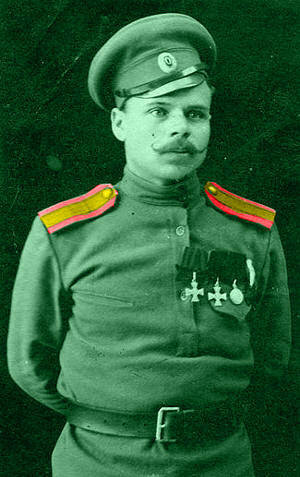 The ensign of the 10 Infantry Regiment of the New Ingermanland Regiment Grigory Selinchuk, March 1916 of the year.
The ensign of the 10 Infantry Regiment of the New Ingermanland Regiment Grigory Selinchuk, March 1916 of the year.After the assignment of platoon commanders to the regular category of chief officers, only assistant platoon commanders began to produce ensigns. Since 1907, the title has been awarded exclusively to extra-conscripts. Their epaulettes acquired a hexagonal shape, like those of officers. On the chase, the ensigns had a longitudinal stripe of a harness galloon 5/8 inches wide in color according to the instrumental metal of the regiment. In addition to this patch, they wore transverse patches for their position. Two stripes - for the positions of a separated non-commissioned officer, three stripes - for the positions of a platoon non-commissioned officer, one wide - for the positions of a sergeant major. In other positions, ensigns did not have transverse stripes. The salary of a lieutenant in 1913 was 28,5 rubles per month in the first three years of service and 33,5 rubles in the next. For the passage of the first two years of service, the ensign received a 150-ruble lump-sum allowance, and for 10 years of continuous service - a lump-sum allowance of a thousand rubles.
It should be borne in mind that since 1826 in the guard (the so-called “old guard”), the ensigns were equal to the army lieutenants, but did not belong to the corresponding class of the Table of Ranks, in contrast to the sergeants and sergeant sergeants who were previously older than them. Since 1843, junkers have been equated with the ensigns in the legal relation and the same insignia have been established for them - epaulets, trimmed around the edge with a narrow golden galloon. Sub-ensigns (usually from noblemen), appointed to perform the duties of officers (commanders of separate units, etc.), wore a sword belt with chief officer galloon and officer lanyard in the cold weapons, and until 1907 they were called warrant officers, or, in the absence of grounds for subsequent production as chief officers, as ordinary warrant officers (until 1884), although contrary to widespread misconception this was not a separate rank or position at that time. According to the status, the warrant officer was equal to the soldier-junker. Despite the general similarity to the indistinguishability of the status of a warrant officer and ensign-warrant officer before 1907, the fundamental difference between them was that the warrant officer could not wear an officer uniform and insignia, under the title "Your Honor", etc. e. remained just a non-commissioned officer, albeit acting as an officer.
If the non-commissioned officer was made as a second lieutenant for distinction or as a candidate for production as chief officers, he wore a noncommissioning officer in his previous rank (Feldwebel or senior non-commissioned non-commissioned officer).
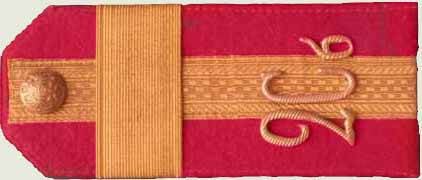 Shoulder strap under the lieutenant to the post of sergeant. The 2 Siberian Rifle General-Adjutant General of the Muravyev-Amur Regiment.
Shoulder strap under the lieutenant to the post of sergeant. The 2 Siberian Rifle General-Adjutant General of the Muravyev-Amur Regiment.From 1801, non-commissioned officers from the nobility, who had served for at least three years in rank, were granted the right to serve as warrant officer upon retirement. Other non-commissioned officers, when dismissed on indefinite leave or resignation, could be encouraged by awarding the next rank. In practice, most often non-commissioned officers were made sub-ensigns or conductors. The position of the Guards Secondary ensigns was special - even without being promoted to the guard, the ensigns could resign as “army officers” or enter civil service. In this case, for example, up to 1859, the ensign of the guard could resign or be transferred to the army as an army second lieutenant. For cavalry, such a practice was only permitted on cornets when it passed the exam for the cavalry junkers training program.
According to the statute of the insignia of the Military Order (of the Cross of St. George) from 1913, the ensigns (of course, in those types of troops and units where this title existed) were any military personnel who were awarded the 1 degree and were awarded 2 degree sub-ensigns when resigning or retiring. With the beginning of the First World War, this rule became systematically violated.
23 November 1917, the rank of sub-ensign was canceled, like all other ranks, titles and titles.
Information